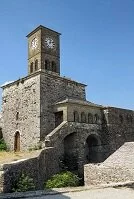Architecture of Albania

Gjirokaster
The earliest examples of architecture to be found in Albania can be found in Butrint, which has been occupied by the Greeks, Romans, and Venetians among others. Although these sites are now in ruins, they provide the best example of this architectural age in Albania.
The next major influences to Albania came in quick succession in the 1200-1300s with the Byzantines and in the 1400s with the Ottoman Turks. The city of Berat is home to the best remaining examples of Byzantium architecture, although much of the city is in the Ottoman style. The town of Gjirokastra is primarily in the Ottoman style as well, much of which was built in the 1600-1700s.